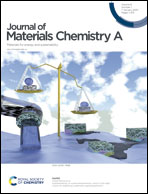Dense organic molecules/graphene network anodes with superior volumetric and areal performance for asymmetric supercapacitors†
Abstract
Volumetric and areal capacitance are as important as gravimetric capacitance for small energy storage devices. However, achieving both a high volumetric and a high areal capacitance is still a big challenge. Here we report a dense redox organic molecules/graphene network, in which highly redox active sodium anthraquinone-2-sulfonate (AQS) molecules are anchored on interconnected and highly conductive graphene sheets by noncovalent π–π interactions to form high-performance supercapacitors (SCs). The AQS/graphene (AQS/G) has a high volumetric specific capacitance of up to 650 F cm−3 and an excellent rate capability (422 F cm−3 even at 30 A g−1), as well as a good cycling stability. A maximum areal specific capacitance of 13.3 F cm−2 is achieved at a high mass loading of 32 mg cm−2 (200 μm in thickness), which is amongst the highest values recorded for organic-based materials for SCs. An asymmetric SC constructed with AQS/G and RuO2/graphene delivers a maximum volumetric energy density of 44 W h L−1. This outstanding performance is attributed to the excellent electron conduction and ion transport provided by the dense but interconnected graphene network. This work suggests a new way for organic-based high-performance electrode materials to be used in electrochemical energy storage devices.



 Please wait while we load your content...
Please wait while we load your content...